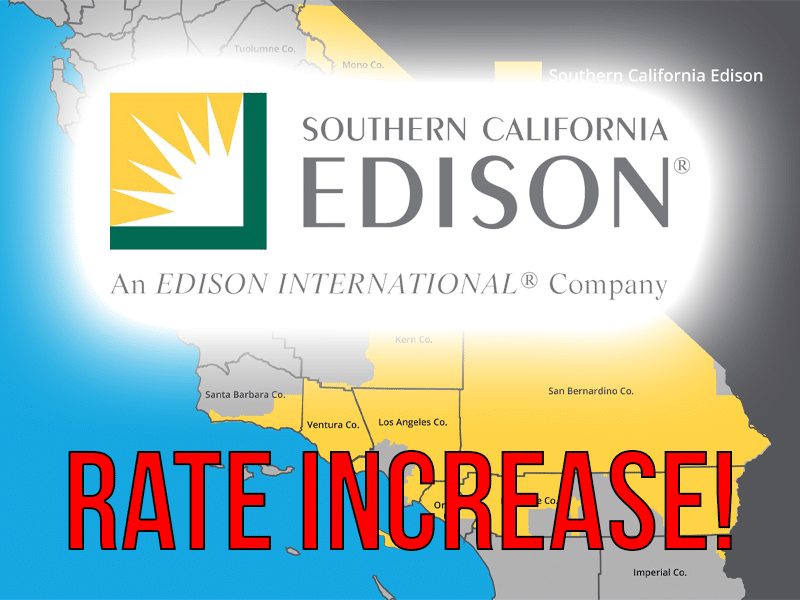
The SCE rate increase of 2024 is upon us! The new year is supposed to bring fresh starts and new beginnings. But for many California residents, the month of January brought an unpleasant surprise. Just as people were settling into the new year, letters arrived from South California Edison (SCE) announcing rate increases for 2024.
The electric utility company serves around 15 million people across 50,000 square miles in central, coastal, and southern California.
For many, the new year was starting off with questions about how much their utility bills will increase and how they will pay for them.
SCE Rate Increase of 2024 By the Numbers
In 2022, SCE increased its rates by 17%, causing most customers to shell out an additional $85 on their electricity bills. Further increases were effective January 1st, 2024.
The average residential electric bill is set to jump from $143.33 to $175.39—a 7.21% increase. And unfortunately, Residential California Alternate Rates for Energy (CARE) customers are not off the hook, with an expected increase of 7.84% in their electricity bills.
Reason for SCE rate increase of 2024
SCE has stated that these rate increases are necessary to cover the rising costs of purchased power and ongoing grid maintenance and repair.
According to SCE’s notice regarding the new utility rates, the prices will be applied to capital investments authorized in SCE’s General Rate Case (GRC) application, as well as others. In other words, the funds collected from rate increases will finance infrastructure improvements planned by SCE. These have been approved by the California Public Utilities Commission (CPUC).
SCE also stated that these rate increases are necessary to fairly compensate its shareholders and attract capital to meet its obligations to serve its customers safely and reliably.
Lastly, SCE claims that the increased prices will allow the company to mitigate financial risks related to California’s wildfires.
On the surface, SCE’s reasoning for increasing rates is quite reasonable. Capital investments and attracting capital are essential for any business to operate efficiently and meet its obligations to customers. Additionally, mitigating financial risks related to wildfires is an important responsibility for any utility company operating in California.
However, the reality is that rate increases are a tremendous burden on customers, especially those who are already struggling to make ends meet. It is especially challenging for those who rely on programs like CARE to be able to pay their electricity bills.
SCE’s claims that it needs to raise rates to mitigate financial risks related to wildfires might also ring hollow to customers. Thousands of Californians have lost their homes, businesses, and lives in recent years due to devastating fires that were, in some cases, linked to utility equipment failures.
It is ultimately up to customers to decide whether they feel that these rate increases are justified, given the current economic and environmental landscape in California.
Have You Had Enough of Expensive Utilities? Switch to Solar
This will not be the last SCE price hike this year and in the future. In fact, several other energy players in California, like PG&E, Southwest Gas, SDG&E, and SoCalGas, to name a few, have all increased their prices in 2024.
With the continued need for energy, there will likely be more of the same in the coming years.
Adopting solar power is one of the easiest and most practical ways for homeowners to gain an edge against such price hikes from utility entities.
The benefits of switching to solar are many:
A Fair Degree of Energy Independence
By installing solar panels on their roofs, homeowners can generate their own electricity and reduce their dependence on utility providers’ grids. This is a great way to reduce their monthly electricity bills.
Unlocking Energy Efficiency
SCE and other utility providers charge higher rates during peak hours, typically in the afternoon and evening, when people use more electricity. By using energy-efficient appliances, adjusting their thermostat, and shifting their energy usage to off-peak hours, homeowners can reduce their dependence on the increasingly expensive grid and save money along the way.
To this end, installing a solar system with energy storage (batteries) and monitoring bring multi-pronged benefits. With the ability to store excess energy generated during the day—by virtue of the sun and solar cells—homeowners can tap into it during peak hours. This handily minimizes the need for utility-provided electricity and reduces overall expenses.
Needless to say, saving money on energy bills and reducing a household’s reliance on utility-provided electricity is possible.
Furthermore, the energy monitoring feature can help homeowners track energy usage and identify opportunities to optimize the system’s performance. When homeowners know the times of day they use the most energy, it becomes easier to find ways to reduce their overall consumption.
Incentivized Adoption
It’s been established that solar power can help homeowners save money on their monthly electricity bills. But adopting a solar power system also gives them access to various incentives and programs to reduce upfront installation costs.
California offers federal, state, and local incentives to homeowners who want to leverage solar power with benefits. These incentives can be categorized into two broad categories: tax incentives and rebates.
Tax Incentives
Tax incentives include the Federal Solar Investment Tax Credit—30% of the cost of installing solar and battery storage systems until 2032.
California’s Active Solar Energy System Exclusion exempts rooftop solar systems installed before January 1, 2025, from property valuations. This means the installations do not increase the property tax.
With the Property-Assessed Clean Energy (PACE) program, the upfront cost of the solar project is paid through an increase in the property tax bill over agreed-upon terms of 5 to 20 years.
Rebates
The Self-Generation Incentive Program (SGIP) provides reimbursements of $150 to $1,000 per kWh of battery storage installed, depending on the utility, wildfire risk, and special circumstances.
Disadvantaged Communities – Single-Family Solar Homes (DAC-SASH) is another rebate program for qualified low-income households. It provides an upfront rebate to reduce the cost of switching to solar.
Many local rebates can further maximize solar savings. A good example is Rancho Mirage Energy Authority’s Residential Solar Rebate Program, which offers a one-time $500 incentive for installing or expanding a residential solar system. There is also Sacramento Municipal Utility District (SMUD), which has a $150 stipend for residential solar system installations.
The federal government also offers a tax credit for homeowners who adopt solar power, which can significantly reduce the upfront cost of installation.
Long-term Benefits
Adopting solar power has long-term benefits as well. Solar panels can last up to 25 years or longer, and homeowners can expect to see a significant return on investment over the life of the panels.
In addition, solar power systems increase the value of a home, making it more attractive to potential buyers in the future.
It Is the Perfect Time To Embrace Solar
The recent price hike by SCE and other utility providers may be a wake-up call for homeowners to explore alternative energy sources like solar power. By adopting solar, homeowners can save on energy bills, take charge of their electricity needs, and contribute to a cleaner environment.
With the benefit of various incentives and rebates, going solar has never been easier, and it is the way of the future.

Authored by Ryan Douglas
NRG Clean Power's resident writer and solar enthusiast, Ryan Douglas covers all things related to the clean energy industry.


